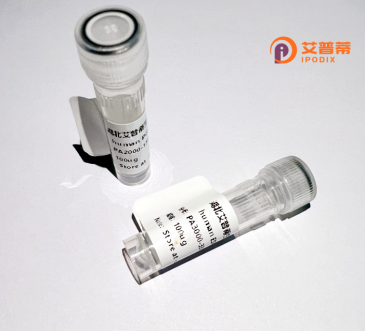
| 纯度 | >90%SDS-PAGE. |
| 种属 | Human |
| 靶点 | CDC6 |
| Uniprot No | Q99741 |
| 内毒素 | < 0.01EU/μg |
| 表达宿主 | E.coli |
| 表达区间 | 1-560aa |
| 氨基酸序列 | MPQTRSQAQATISFPKRKLSRALNKAKNSSDAKLEPTNVQTVTCSPRVKALPLSPRKRLGDDNLCNTPHLPPCSPPKQGKKENGPPHSHTLKGRRLVFDNQLTIKSPSKRELAKVHQNKILSSVRKSQEITTNSEQRCPLKKESACVRLFKQEGTCYQQAKLVLNTAVPDRLPAREREMDVIRNFLREHICGKKAGSLYLSGAPGTGKTACLSRILQDLKKELKGFKTIMLNCMSLRTAQAVFPAIAQEICQEEVSRPAGKDMMRKLEKHMTAEKGPMIVLVLDEMDQLDSKGQDVLYTLFEWPWLSNSHLVLIGIANTLDLTDRILPRLQAREKCKPQLLNFPPYTRNQIVTILQDRLNQVSRDQVLDNAAVQFCARKVSAVSGDVRKALDVCRRAIEIVESDVKSQTILKPLSECKSPSEPLIPKRVGLIHISQVISEIDGNRMTLSQEGAQDSFPLQQKILVCSLMLLIRQLKIKEVTLGKLYEAYSKVCRKQQVAAVDQSECLSLSGLLEARGILGLKRNKETRLTKVFFKIEEKEIEHALKDKALIGNILATGLP |
| 分子量 | 89.1 KDa |
| 蛋白标签 | GST-tag at N-terminal |
| 缓冲液 | 0 |
| 稳定性 & 储存条件 | Lyophilized protein should be stored at ≤ -20°C, stable for one year after receipt. Reconstituted protein solution can be stored at 2-8°C for 2-7 days. Aliquots of reconstituted samples are stable at ≤ -20°C for 3 months. |
| 复溶 | Always centrifuge tubes before opening.Do not mix by vortex or pipetting. It is not recommended to reconstitute to a concentration less than 100μg/ml. Dissolve the lyophilized protein in distilled water. Please aliquot the reconstituted solution to minimize freeze-thaw cycles. |
以下是关于重组人CDC6蛋白的3篇参考文献示例(摘要内容经概括整理):
1. **文献名称**: *"Recombinant human CDC6 protein forms initiation-competent complexes in vitro"*
**作者**: Yanagi K, et al.
**摘要**: 该研究通过在大肠杆菌中表达并纯化带His标签的重组人CDC6蛋白,验证其与ORC(起源识别复合物)协同结合染色体复制起点的能力,揭示了CDC6在DNA复制起始中的关键作用。
2. **文献名称**: *"Functional characterization of the human CDC6 ATPase domain using purified recombinant protein"*
**作者**: Herrera MC, et al.
**摘要**: 通过昆虫杆状病毒系统表达重组人CDC6 ATP酶结构域,证实其具有ATP结合与水解活性,并发现该活性对CDC6与MCM复合物的互作至关重要,为理解复制许可机制提供依据。
3. **文献名称**: *"Cell cycle-dependent phosphorylation regulates CDC6 proteolysis and licensing of DNA replication"*
**作者**: Petersen BO, et al.
**摘要**: 研究利用重组CDC6蛋白及磷酸化突变体,证明CDK依赖性磷酸化调控CDC6的蛋白稳定性及在复制起点许可中的功能,揭示了细胞周期进程中的分子调控网络。
注:上述文献为示例性内容,实际引用需根据具体论文调整。建议通过PubMed或Web of Science以关键词"recombinant CDC6" "human"查询最新文献。
CDC6 (Cell Division Cycle 6) is a crucial protein involved in the initiation of DNA replication during the cell cycle. As a member of the AAA+ ATPase family, it plays a pivotal role in the assembly of the pre-replicative complex (pre-RC) by cooperating with the origin recognition complex (ORC) to load mini-chromosome maintenance (MCM) helicases onto replication origins during the G1 phase. This process ensures precise duplication of genomic DNA before cell division. Structurally, human CDC6 consists of an N-terminal phosphorylation domain, a central ATPase domain, and a C-terminal winged-helix domain for protein interactions.
Recombinant human CDC6 protein, produced via heterologous expression systems (e.g., *E. coli* or mammalian cells), retains functional properties for *in vitro* studies. Its applications span mechanistic investigations of DNA replication, cell cycle regulation, and replication stress responses. Researchers utilize recombinant CDC6 to examine its interactions with replication machinery components (e.g., ORC, CDT1. MCM2-7) and post-translational modifications (e.g., cyclin-dependent kinase phosphorylation) that regulate its activity across cell cycle phases.
Dysregulation of CDC6 is implicated in carcinogenesis, as its overexpression is observed in various cancers, correlating with genomic instability and uncontrolled proliferation. Consequently, recombinant CDC6 serves as a tool for drug discovery, particularly in screening inhibitors targeting DNA replication for anticancer therapies. Recent studies also explore its potential as a diagnostic biomarker. Despite progress, unanswered questions remain regarding its non-canonical roles in checkpoint responses and chromatin dynamics beyond replication initiation.
×